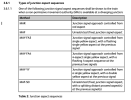Hi all,
I've read the rule book and it states that a double flashing yellow, followed by a single yellow flashing, and so on, indicates, you are coming to a diverging junction where the diverging route is of a slower speed.
Is this the case at all diverging junctions around the country?
Would there not be flashing yellows if the speed of the diverging junction were the same?
If there were several diverging routes at a junction all with slower speeds, would flashing yellows be used in approach to them all. (plus an indicator) ?
Finally,
I've heard it referred to as a, 'highest speed diverging route'. Isn't this a contradiction of what is happening.
Thanks
I've read the rule book and it states that a double flashing yellow, followed by a single yellow flashing, and so on, indicates, you are coming to a diverging junction where the diverging route is of a slower speed.
Is this the case at all diverging junctions around the country?
Would there not be flashing yellows if the speed of the diverging junction were the same?
If there were several diverging routes at a junction all with slower speeds, would flashing yellows be used in approach to them all. (plus an indicator) ?
Finally,
I've heard it referred to as a, 'highest speed diverging route'. Isn't this a contradiction of what is happening.
Thanks


